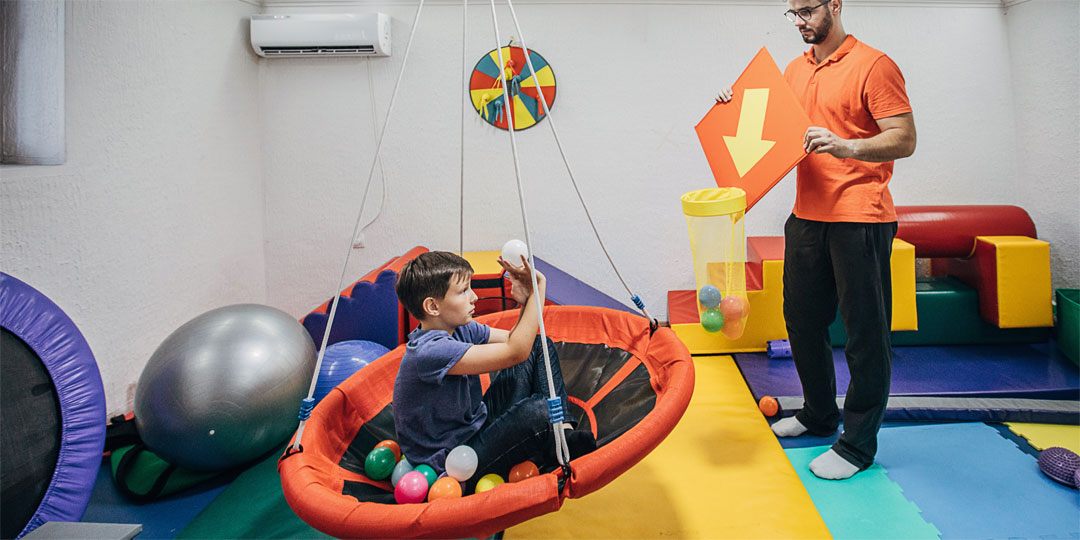General Information
Sensory Rooms: A Calming Oasis for Children with Vestibular Sensory Processing Disorder
Did you know that there are 7 senses, not just 5? The 5 senses we’re all familiar with are sight, hearing, smell, taste, and touch. But two other senses are just as important: proprioception and vestibular sensory processing disorder.

Proprioception is the sense of our body’s position in space. It helps us know where our arms and legs are, how our body is oriented, and how much force we use.
Vestibular sensory processing disorder.is the sense of balance. It helps us keep our balance and stay upright.
All of our senses work together to help us make sense of the world around us. They help us learn, explore, and interact with our environment.
Sensory sensitivity is when someone is more or less sensitive to certain sensory stimuli than most people. For example, loud noises might easily overwhelm someone with sensory sensitivity to sound. Someone with sensory sensitivity to touch might be uncomfortable with certain textures or fabrics.
Sensory seeking is when someone craves specific sensory experiences. For example, someone with sensory seeking might enjoy spinning around or jumping up and down. Someone with sensory seeking might also enjoy feeling different textures or tasting different foods.
How we all are different when it comes to sensory input
We all have different sensory thresholds, meaning we all have different sensitivity to sensory input. Some people are more sensitive to sound, while others are more sensitive to touch. Some people are more susceptible to light, while others are more sensitive to smell.
There is no right or wrong way to be regarding sensory sensitivity. However, if someone’s sensory sensitivity is causing them difficulty in their daily life, seeking help is essential.

Ideas for creating a sensory-friendly environment
If you think your child may have sensory sensitivity, there are a few things you can do to create a sensory-friendly environment for them.
- Use soft lighting and calming colours.
- Reduce noise levels.
- Provide comfortable seating and surfaces.
- Offer a variety of textures to touch.
- Allow your child to move around freely.
You can also create a sensory room for your child. Creating a sensory room for your child is a fantastic way to provide them with a safe and stimulating environment that supports their sensory needs. The possibilities for sensory room activities are as diverse as the needs and preferences of each child.

Here, we’ve gathered some wonderful:
Swings That Soothe: Incorporate swings to give your child gentle movement and a calming rhythm. Swinging can be immensely comforting, aiding in sensory regulation and emotional balance.
Balls for Play and Tactile Stimulation: Introducing a variety of balls can offer tactile exploration and motor skill development. From textured to bouncy, these spheres engage various senses while encouraging physical activity.
Puzzles for Cognitive Delight: Puzzles provide both cognitive challenge and sensory stimulation. Different textures and shapes add an extra layer of sensory engagement, making puzzle time an enriching experience.
Mesmerising Water Features: The sight and sound of flowing water can be remarkably soothing. Incorporate water features like bubbling fountains or interactive water walls to create a calming auditory and visual experience.
Dazzling Colourful Lights: Illuminate the sensory room with various colourful lights. Calming shades can create a serene atmosphere, while vibrant hues stimulate the visual senses in a captivating way.
Soft Textures and Fabrics: Introduce a variety of soft fabrics and textures to provide tactile comfort and sensory exploration. From plush cushions to silky scarves, these textures engage the sense of touch in delightful ways.
A sensory room is a specially designed space filled with sensory-stimulating activities. These activities can help children with sensory processing issues to calm down, focus, and relax.
Sensory rooms can be found in schools, hospitals, and other healthcare facilities. They can also be found in some homes.
If you’re considering creating a sensory room for your child, there are a few things you need to keep in mind. First, you need to choose the right location for the room. The room should be quiet and away from noise. It should also be large enough for your child to move around freely.
Second, you need to choose the right activities for the room. The activities should be calming and relaxing for your child. They should also be safe and appropriate for your child’s age and development level.
Finally, it would be best to ensure the room is well-maintained. The activities should be cleaned and replaced regularly. The room should also be kept clean and organised.
If you’re concerned that your child may have sensory issues, you must talk to their doctor. They can help you assess your child’s needs and develop a plan to help them thrive.
You can also book a free consultation with Marga, a pediatric occupational therapist specialising in sensory processing. Marga can help you create a sensory-friendly environment for your child and develop a sensory diet to help them manage their sensory needs.